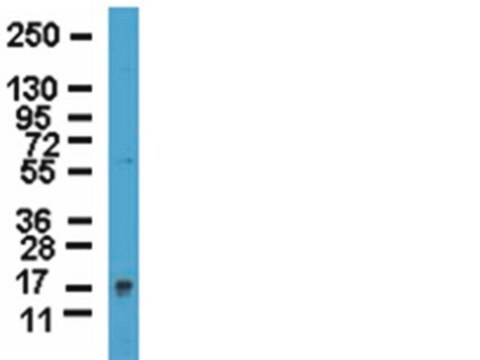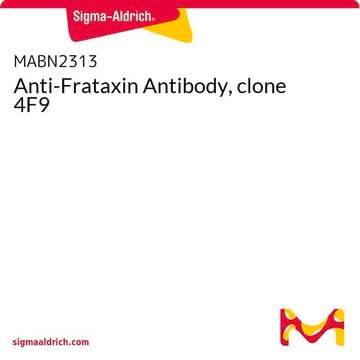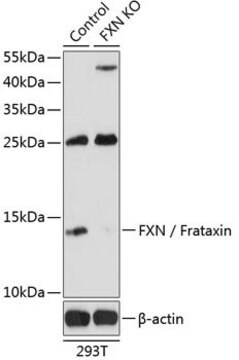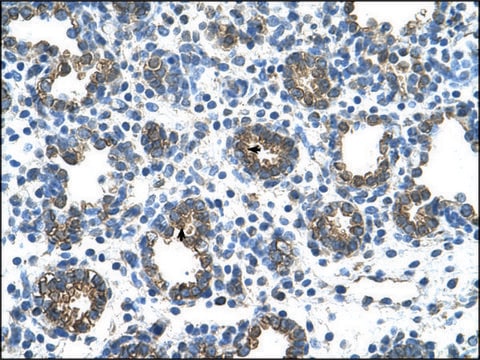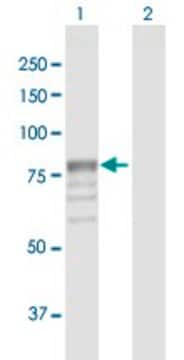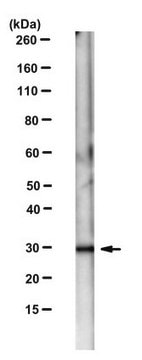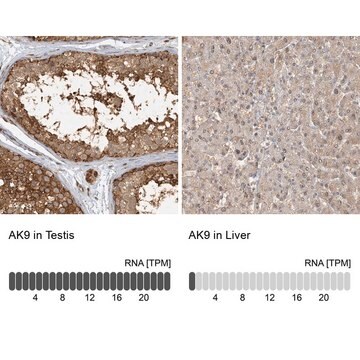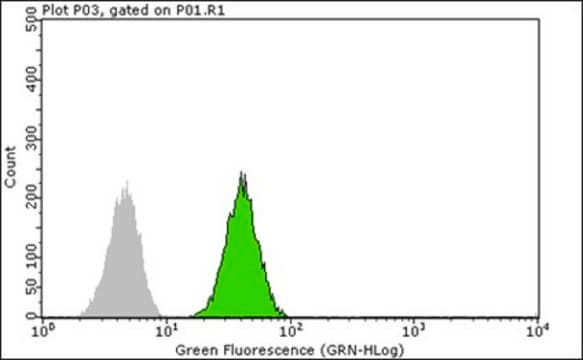MAB1594
Anti-Frataxin Antibody, exon 4, clone 1G2
ascites fluid, clone 1G2, Chemicon®
Sinonimo/i:
Friedreich ataxia, Friedreich ataxia protein
About This Item
Prodotti consigliati
Origine biologica
mouse
Livello qualitativo
Forma dell’anticorpo
ascites fluid
Tipo di anticorpo
primary antibodies
Clone
1G2, monoclonal
Reattività contro le specie
human, rat, mouse
Produttore/marchio commerciale
Chemicon®
tecniche
ELISA: suitable
immunocytochemistry: suitable
immunofluorescence: suitable
western blot: suitable
Isotipo
IgG1κ
N° accesso NCBI
N° accesso UniProt
Condizioni di spedizione
dry ice
modifica post-traduzionali bersaglio
unmodified
Informazioni sul gene
human ... FXN(2395)
mouse ... Fxn(14297)
rat ... Fxn(499335)
Descrizione generale
Specificità
Immunogeno
Applicazioni
1:100-1:1,000. Fixation of cells in ice cold acetone or 4% paraformaldehyde is recommended. Due to the subcellular localization of frataxin in the mitochondria, cells should be permeabilized in the presence of detergent prior to incubation with primary antibody.
ELISA:
A previous lot of this antibody was used on ELISA.
Western blot (natural and recombinant protein):
1:5,000; mitochondrial preparations are recommended for consist signals (see Santos, 2001).
Optimal working dilutions must be determined by the end user.
Qualità
Western Blot Analysis:
1:1000 dilution of this lot detected Frataxin on 10 μg of PC12 lysates.
Descrizione del bersaglio
Stato fisico
Stoccaggio e stabilità
Handling Recommendations: Upon first thaw, and prior to removing the cap, centrifuge the vial and gently mix the solution. Aliquot into microcentrifuge tubes and store at -20°C. Avoid repeated freeze/thaw cycles, which may damage IgG and affect product performance
Risultati analitici
Liver, heart or skeletal muscle.
Altre note
Note legali
Not finding the right product?
Try our Motore di ricerca dei prodotti.
Codice della classe di stoccaggio
11 - Combustible Solids
Classe di pericolosità dell'acqua (WGK)
WGK 1
Punto d’infiammabilità (°F)
Not applicable
Punto d’infiammabilità (°C)
Not applicable
Certificati d'analisi (COA)
Cerca il Certificati d'analisi (COA) digitando il numero di lotto/batch corrispondente. I numeri di lotto o di batch sono stampati sull'etichetta dei prodotti dopo la parola ‘Lotto’ o ‘Batch’.
Possiedi già questo prodotto?
I documenti relativi ai prodotti acquistati recentemente sono disponibili nell’Archivio dei documenti.
Il team dei nostri ricercatori vanta grande esperienza in tutte le aree della ricerca quali Life Science, scienza dei materiali, sintesi chimica, cromatografia, discipline analitiche, ecc..
Contatta l'Assistenza Tecnica.